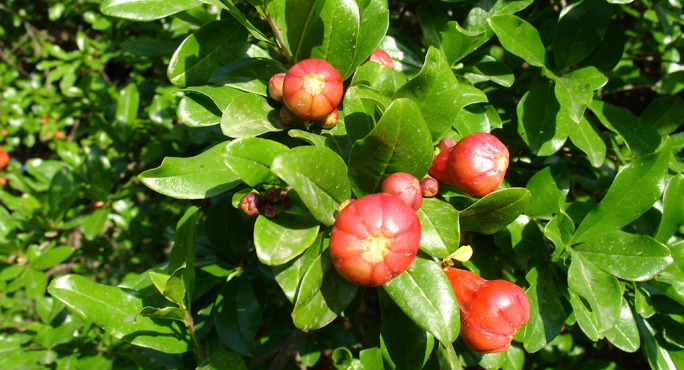Photo courtesy Fox News Health
I recall eating pomegranate as a kid, figuring out the best way to get the firm, juicy fruit off of the super-abundant seeds. A couple of years ago, I had the opportunity to tour much of Morocco’s countryside and to meet many people who work with medicinal and beneficial plants. One day several hours outside of Casablanca, I was touring through a pomegranate orchard. There I saw, for the first time, this fruit that has recently captured the imagination of people here in the U.S. in recent years.
The pomegranate tree, Punica granatum, is native from Iran to the Himalayas of northern India and has been cultivated since ancient times throughout the Mediterranean region of Asia, Europe and Africa. The Latin name Punica granatum means “seeded apple.” The fruit appeared in Egyptian mythology and art, is praised in the Old Testament of the Bible and in the Koran, and was carried by desert caravans for its flavorful and refreshing juice. It traveled to central and southern India from Iran about the first century A.D. and was reported growing in Indonesia in the early 1400’s. The most important growing regions are Egypt, China, Afghanistan, Pakistan, Bangladesh, Iran, Iraq, Morocco, India, Burma, Saudi Arabia and California.
The pomegranate is a neat, rounded shrub or small tree that can grow to 20 or 30 ft., but more typically to 12 to 16 ft. in height. Pomegranates are typically long-lived. Some specimens in Europe are known to be over 200 years of age. Pomegranate produces a nearly round fruit two and a half to five in. wide. The tough, leathery skin is typically yellow overlaid with light or deep pink or rich red. The interior is separated by membranous walls and spongy white tissue into compartments packed with sacs filled with sweetly juicy, red or whitish pulp. Each sac contains one angular seed.
Compounds and Medicinal Uses
Pomegranate juice is used as a folk remedy to treat diarrhea. Pomegranate juice is used in preparations for treating dyspepsia, or indigestion. The fruit contains hundreds of known compounds, including some especially potent antioxidant phenols, some of which demonstrate significant anti-cancer and anti-proliferative effects. Anti-proliferation refers to inhibiting the growth of tumors. The fruit also contains phytosterols, the anti-cancer compound ellagic acid and chlorogenic acid, which possesses both well documented anticancer and anti-inflammatory activity. The fruit also contains starch, sugars, additional anti-inflammatory constituents and virus-inhibiting agents. The seed of the fruit is the richest known source of estrone, which possesses sexual function and reproductive-enhancing activity.
Pomegranate has received a great deal of attention in more recent times as an antioxidant superfood, of especial purported benefit to the cardiovascular system. Antioxidants in pomegranate are known to lower LDL cholesterol, inhibit oxidation of LDL cholesterol, and inhibit platelet aggregation. In one human study conducted in Iran, pomegranate juice lowered cholesterol levels in patients with diabetes.
Cell studies show that antioxidant compounds called ellagitannins in pomegranate kill some types of cancer cells. One fraction of pomegranate juice demonstrates anti-HIV activity. Pomegranate also shows anti breast cancer cell activity In Vitro.
Now, what I don’t want is for anyone to imagine that with all its anticancer compounds, pomegranate is a cancer cure. It is not. But pomegranate, and other high antioxidant fruits, can unquestionably help to reduce the risk of many types of cancer. This is where these fruits come into play in a healthy diet. If we consume the protective foods, like pomegranate, turmeric, ginger, green tea and acai, we take in compounds that help our bodies to prevent the formation of cancers. Prevention is the big factor here. If we take care to eat well, drink pure water and exercise, we can avoid many of the diseases that ruin people’s lives.
Pomegranate was a minor fruit for the longest time, little used in the U.S., and its availability was pretty much relegated to California where it is grown. But the current popularity of pomegranate juice, and the promotion of its healthful benefits, has made this fruit and its delicious juice a star. For all the benefits it possesses, pomegranate wouldn’t be of much interest to most people if not for its wonderful flavor. But this fruit delivers flavor in spades, along with its numerous health benefits.


